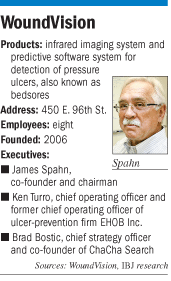Subscriber Benefit
As a subscriber you can listen to articles at work, in the car, or while you work out. Subscribe Now
A local doctor-turned-entrepreneur is planning to launch by year’s end his latest and greatest device—an infrared
scanner to detect the formation of bedsores, one of the biggest hospital-acquired afflictions.
Head and neck surgeon James Spahn and his team have spent the last five years working on the device, which detects temperature
differences in the skin. Without harmful radiation, it looks for metabolic activity often unseen to the naked eye that indicates
a pressure ulcer—or bedsore—is forming.
The product by Spahn’s Indianapolis-based WoundVision is married to a sophisticated software program. It not only analyzes
the scan results for the probability of bedsore formation, but also crunches data a caregiver enters about a patient’s
medical condition.
“We have been working on this for 4-1/2 years now and we have a tremendous database,” he said.
Spahn may be best known for his 25-year-old company EHOB Inc., which makes devices to prevent bedsores, such as its Waffle
Mattress Overlay. The company, with about 120 employees, generates more than $20 million a year in revenue.
He got the idea for the WoundVision device about five years ago, when Medicare proposed (and later approved) disallowing
payments to treat bedsores.
The average hospital incurs $400,000 to $700,000 in direct costs annually to treat bedsores, according to the Journal
of Wound Ostomy and Continence Nursing. That doesn’t include the cost of lawsuits, with the average summary judgment
of around $275,000.
“Pressure ulcers can develop in as little as just a couple hours if a patient in bed is not moved or turned on a regular
basis,” said Fred Berg, of the National Alliance of Wound Care. “Preventing a wound or pressure sore from developing
is a huge cost savings in health care.”
In 2007, Indiana’s rate of pressure ulcers in long-term-care facilities was 8.1 percent, according to the Centers for
Medicare and Medicaid Services.
Spahn said bedside nurses are overworked and often lack training involving bedsores.
“Everybody kept thinking this was a nurse problem. It’s not. It’s a process problem,” he said.
The WoundVision device won’t replace clinicians. The unit asks the care provider to answer about 200 questions about
the patient’s condition. The responses to the assessment are used as part of the predictive modeling.
A scan may then be made with the large- flashlight-sized infrared device. It incorporates a video camera so a caregiver can
spot surface coloration and overlay the infrared images as well. A lesion can be forming 72 hours before it’s visible
to the naked eye.
The data is encrypted and uploaded to WoundVision’s computer. A caregiver can access the data later through the Web.
Trials have been conducted with more than 500 patients, including an evaluation at St. Luke’s Hospital in Toledo.
WoundVision said it has filed a 510(k) premarket notification with the Food and Drug Administration. Spahn won’t elaborate
on the cost of the device, other than to say if a hospital can prevent just one or two serious bedsore cases, “you’ve
paid for the system.”
The revenue potential could be substantial. Spahn estimates there are more than 3 million beds in hospitals and nursing homes
where the device has potential, not including numerous rehabilitation centers.
His firm wouldn’t be the first to target this market, however.
For example, Toledo-based Wellstar International, through subsidiary Trillennium Medical Imaging, has also developed a thermal
imaging system to scout for early signs of bedsores.
“The company seeks to be the first-to-market in deep tissue injury and pressure ulcer detection using its proprietary
infrared imaging system,” Wellstar recently told investors.
Thermographic imaging has been used since the 1970s, but Spahn said he knows of no product with WoundVision’s sophisticated
algorithm.•
Please enable JavaScript to view this content.
